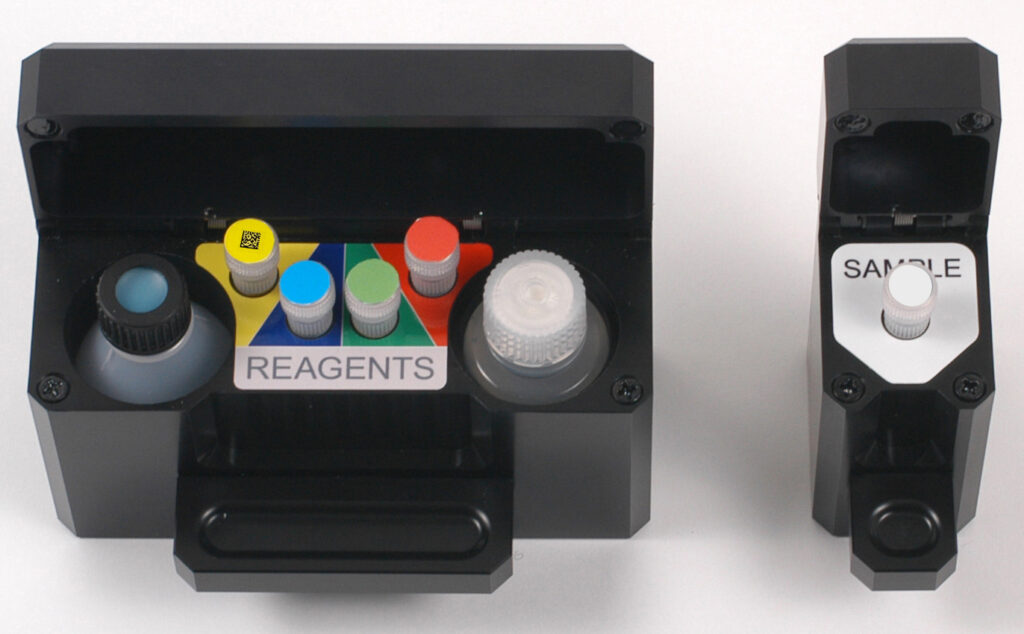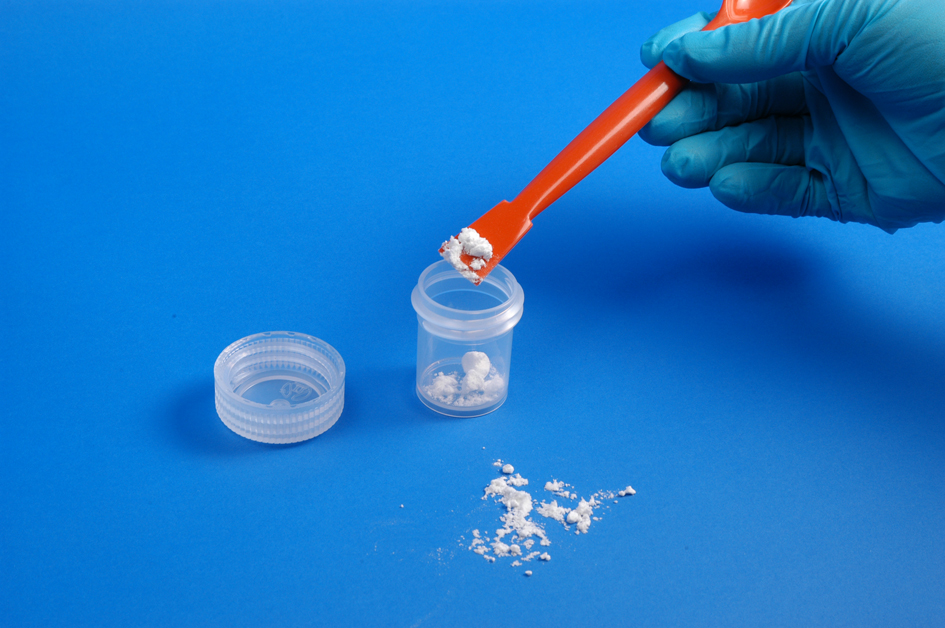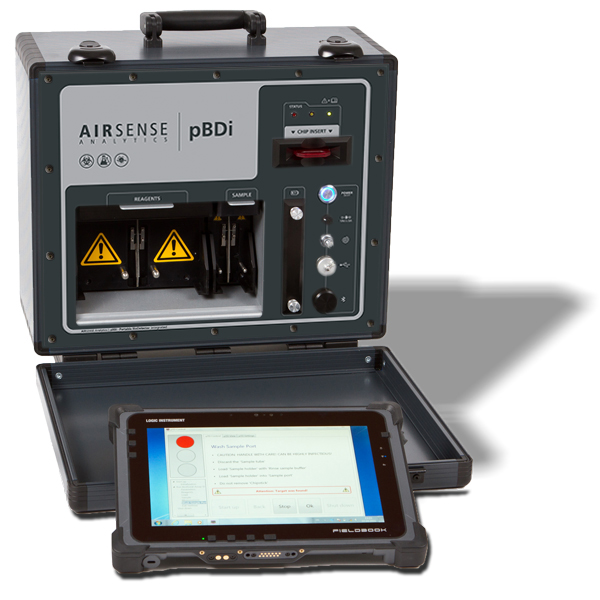By AIRSENSE Analytics
AIRSENSE Analytics introduces the pBDi BioDetector, a portable instrument that can detect toxins, bacteria and viruses on-site in only 20-25 minutes.
In a world where biological threats are evolving, rapid and reliable identification of biothreat agents is of prime importance. Biological events can arise from natural, accidental, or deliberate origins. Historical events such as the cholera epidemic in Haiti from 2010, the Ebola virus disease outbreak in West Africa in 2014, and the ricin letters in the United States in 2013 emphasize the need for rapid detection methods for biothreat agents.
The pBDi from AIRSENSE Analytics introduces a solution to these dangers. It is a portable instrument with automated measurements that significantly reduce analysis time. Apart from those mentioned above, one of the threat scenarios that is intended to be addressed is suspicious shipments in the post offices of state authorities. If you receive a package that contains white powder, hours or days may have passed after sending it to the laboratory until you get the result as to whether it is a hazardous substance or just baking powder. Now, this determination can be made quickly and relatively reliably. pBDi makes it possible to detect toxins, bacteria, and viruses on-site in approximately 20 minutes (without sample preparation).
Immunoassays
This product belongs to the product portfolio of AIRSENSE Analytics GmbH. For over 27 years, AIRSENSE Analytics has been one of the world’s leading manufacturers of analytical security technologies. Their high-quality measuring instruments provide reliable information about chemical compounds in the air. From research and development to production, everything takes place in Schwerin, Germany, making the city a center for cutting-edge technology. The areas of application of their products range from the detection of toxic gases in overseas containers and use at public events to the monitoring of critical infrastructure. In order to cover the range of CBRNe capabilities, AIRSENSE acquired the pBDi-system from Bruker Optics GmbH this year.
The pBDi utilizes an immunoassay-based approach, a widely accepted method for detecting biological agents. Immunoassays rely on the interaction between antibodies and antigens to generate measurable results. In simple terms, it is the lock-and-key concept: antibodies are the locks, and antigens are the keys. When they bind together, it signals the presence of the specific agent being targeted.
The pBDi BioDetector leverages the Enzyme-linked immunosorbent assay (ELISA). More specifically, it employs the principle of sandwich ELISA, which involves capturing the target agent (antigen) between two antibodies, enhancing the specificity and sensitivity of the detection process. The antigens are obtained from the sample being measured.
Ready-to-use test kits are already provided for the measurements. These contain among other things the biochips on which the antibodies are already located.

The pBDi BioDetector employs two amplification principles. First, there is the high turnover of enzymatic reactions, which significantly amplifies the signal, making it easier to detect even trace amounts of the target agent. Second, the redox cycling procedure further enhances sensitivity, providing a robust and reliable means of detection.
What sets the pBDi apart is its use of electrochemical biochips with 16 positions. This means that up to six biothreat agents can be detected at the same time. In addition, the biochip contains positive and negative control electrodes. The mean value of positive control electrodes is defined as 100% signal and the target electrode signals are related to positive control. These biochips are highly sensitive because of the redox cycling amplification that occurs between interdigitated electrodes. The technology of the biochip transforms a binding (biological) event through direct conversation into an electronic signal that can be read by the user on the associated tablet.
One of the standout features of the pBDi BioDetector is its versatility; it can detect toxins, bacteria, and viruses across a wide range of concentrations. For toxins, this ranges from upper picograms per milliliter (pg/ml) to lower nanograms per milliliter (ng/ml). For bacteria, it can detect down to 10³ colony-forming units per milliliter (CFU/ml), and for viruses, down to 9×104 plaque-forming units per milliliter (PFU/ml). Simultaneously, the system can analyze up to six different agents at once, making it a powerful tool for comprehensive threat assessment.

Ready-to-use Test Kits
To facilitate a broad spectrum of analysis, the pBDi BioDetector offers various ready-to-use Test Kits. These kits are designed to detect specific groups of agents efficiently. They include the Toxin Test Kit 1 (covers ricin, staphylococcal enterotoxin B (SEB), and Botulinum Toxin types A, B, and F), the Toxin Test Kit 2 (covers Targets abrin, staphylococcal enterotoxin A (SEA), and Botulinum Toxin types C, D, and E), and the Biothreat Agent Test Kit (covers Detects Bacillus anthracis, Yersinia pestis, Francisella tularensis, Brucella melitensis, Burkholderia mallei, and Smallpox viruses). It is also possible to develop customized chips that can be tailored to detect additional agents as per specific requirements.
The pBDi BioDetector’s capabilities extend to both liquid and solid samples. A powder-like danger is more likely for the area of application in the post offices of state authorities.
Sample preparation is simplified with the pBDi Sample Preparation Kit that includes resuspension and filtration steps. This streamlined process ensures that the system can handle a wide range of sample matrices, providing flexibility in various scenarios, including field deployments.
Operating in potentially hazardous environments is a reality for many first responders and biosecurity personnel, and safety regulations must be adhered to. The pBDi BioDetector takes this into account by making it feasible to operate with full protective equipment. It guarantees safety through an integrated positive and negative control system and even includes an integrated decontamination procedure.

Efficiency in Delivering Results
The pBDi Control Software serves as the brain behind the operation. It allows users to control the pBDi system and ensures that results are presented in an easily interpretable manner. The software employs a traffic light-based color code system to provide a quick overview of results. Signals for each biothreat agent are automatically calculated and displayed, simplifying the decision-making process.
One of the most remarkable features of the pBDi BioDetector is its efficiency in delivering results. With the ready-to-use Toxin Test Kits 1 and 2, it can simultaneously detect six different toxins, including botulinum neurotoxins, staphylococcal enterotoxins, and plant toxins like ricin and abrin. All of this is achieved within just 25 minutes (including sample preparation), thanks to an automated process that minimizes human intervention.
In a world where biological threats can emerge from natural, accidental, or deliberate sources, the pBDi BioDetector from AIRSENSE Analytics stands as a bearer of hope. Its portability, speed, reliability, and versatility make it an indispensable tool for first responders, healthcare professionals, and biosecurity experts alike. Whether it is detecting toxins, bacteria, or viruses, the pBDi BioDetector’s cutting-edge technology, amplification principles, and user-friendly features place it as a vital instrument for safeguarding public health and national security.
AIRSENSE Analytics GmbH was founded on April 15, 1996, by Dipl.-Ing. Wolf Münchmeyer and Dr.–Ing. Andreas Walte in Schwerin, Germany. Both studied at the Technical University of Hamburg-Harburg. Since the beginning, AIRSENSE Analytics has been involved in safety and public security applications and is permanently introducing innovative CBRN detection solutions to international markets.





